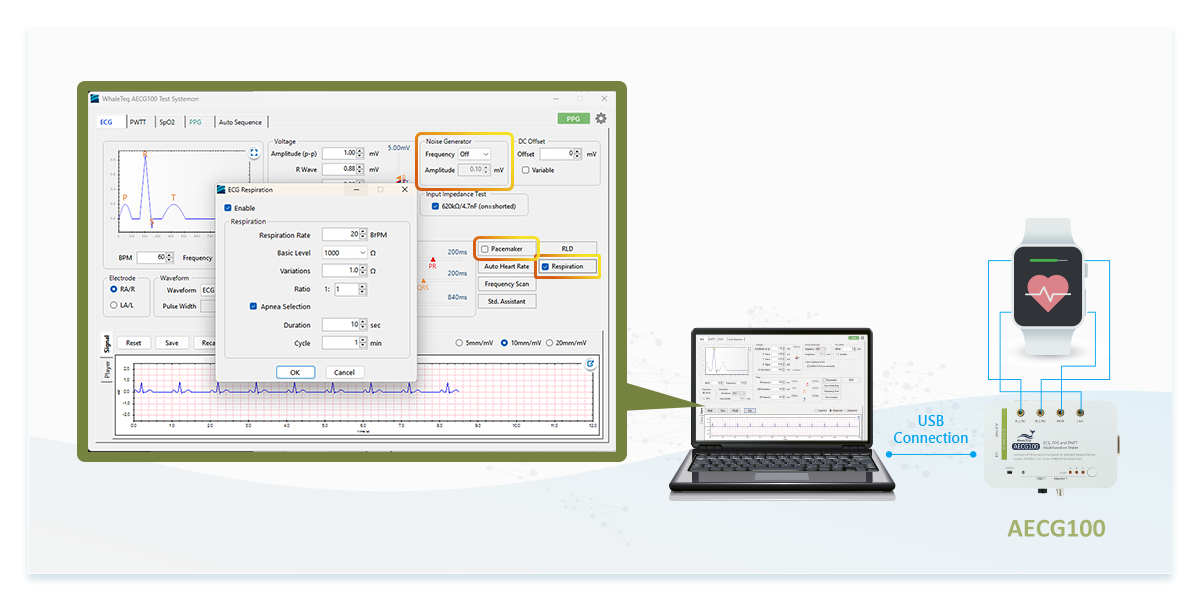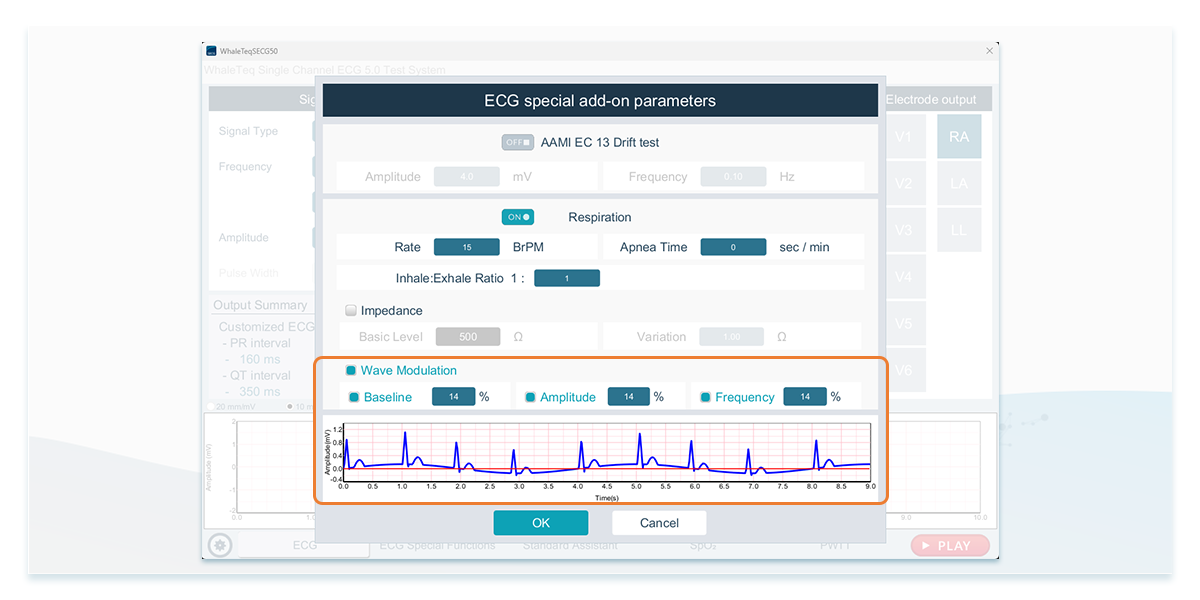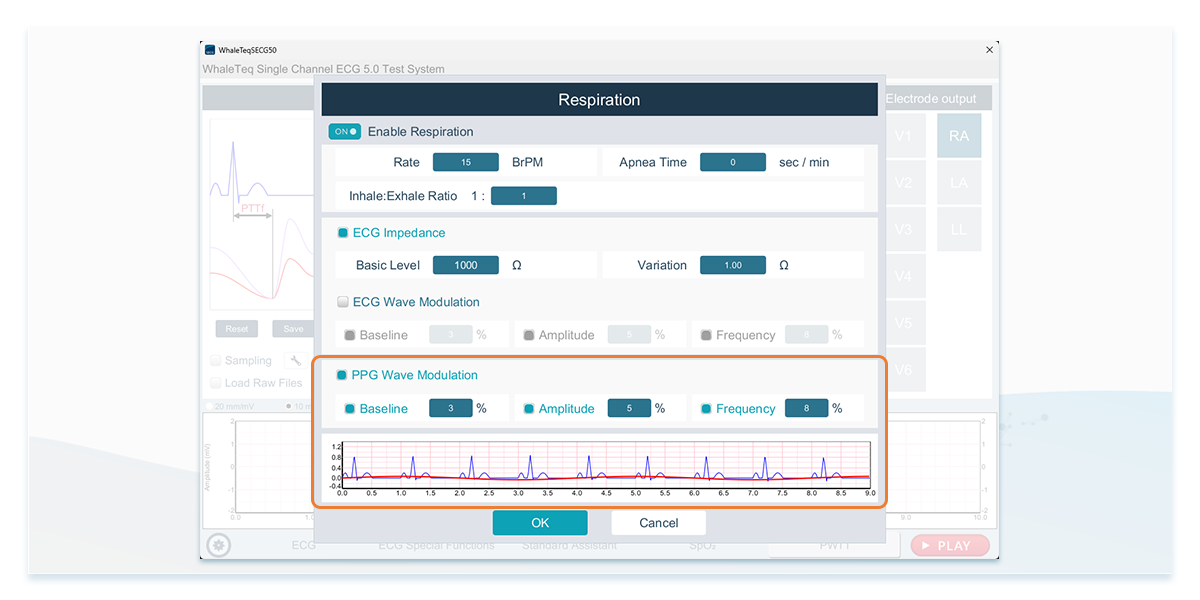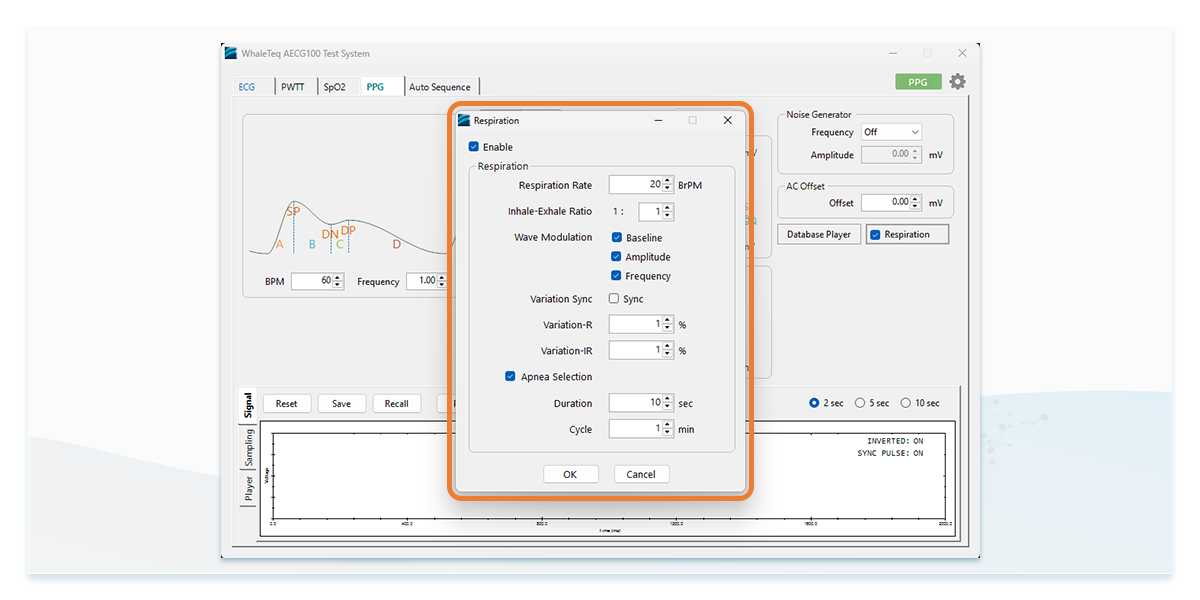Respiratory signals are among the most critical physiological parameters in clinical monitoring. In intensive care units and surgical settings, they serve as an essential indicator of a patient's real-time physiological condition. They are also used to track disease progression and evaluate long-term trends.
This article introduces two mainstream principles used in respiratory signal testing, as well as how respiratory signal simulation technologies can support the verification of respiratory monitoring functions in patient monitors and wearable devices.
Testing Principles
Currently, two primary methods are used to test respiratory signals: Impedance Pneumography (IP) and Wave Modulation. The following sections explain the measurement principles of each approach.
1. Impedance Pneumography (IP)
Inhalation and exhalation cause cyclical expansion and contraction of the thoracic cavity, which in turn results in corresponding changes in electrical impedance. Patient monitors transmit a fixed high-frequency current and measure the resulting impedance variations through Lead I, II, or III to calculate respiration rate.
Simulators replicate this through baseline and time-varying impedance circuits by combining a fixed impedance—representing a stable electrode patch on the skin—with a variable impedance that mimics chest movement during breathing.
By detecting the fixed and variable impedance via the fixed high-frequency current, the patient monitor can estimate the respiration rate.
2. Wave Modulation
Wave modulation includes ECG-derived respiration (EDR) and PPG-derived respiration (PDR), which extract respiratory signals from ECG and PPG data, respectively.
ECG-derived Respiration (EDR)
Respiratory signals extracted from ECG typically exhibit three types of modulation:
(1) Amplitude Modulation (AM)
As the chest and heart shift with respiration, the heart’s electrical axis also shifts, causing variations in ECG amplitude.
(2) Frequency Modulation (FM)
Heart rate may vary during respiration. This variation differs from person to person; for example, some individuals experience a faster heart rate during inhalation.
(3) Baseline Modulation (BM)
During respiration, the movement of the ribcage and diaphragm produces electromyographic (EMG) signals, which result in baseline shifts in the ECG.
PPG-derived Respiration (PDR)
PPG-derived respiratory signals exhibit the same three types of modulation as EDR:
(1) Amplitude Modulation (AM)
Changes in cardiac volume alter the arterial size, which affects reflected light intensity and therefore PPG amplitude.
(2) Frequency Modulation (FM)
Similar to EDR, heart rate variability caused by respiration results in frequency modulation. For example, some people experience a slower heart rate during exhalation.
(3) Baseline Modulation (BM)
Variations in thoracic pressure due to breathing influence blood flow, shifting the PPG signal baseline. This is also referred to as direct current (DC) modulation.
Simulation Methods
Simulators can be used to verify the performance of respiratory monitoring functions in patient monitors or wearable devices, ensuring signal interpretation accuracy and sensitivity.
WhaleTeq offers a range of solutions for both impedance-based and wave modulation–based respiratory signal simulation:
1. Impedance Pneumography (IP)
The SECG 5.0 AIO outputs ECG analog signals and simulates impedance-based respiratory signals for superimposition. It supports apnea simulation and allows customization of inhalation-to-exhalation ratios for advanced testing.
When paired with the Respiration Module, it expands the respiratory measurement range to 100Ω–4500Ω and variation values to 0.0Ω–10.0Ω with a minimum step size of 0.05Ω within the range of 0.0Ω–5Ω.
The module also supports raw data playback, enabling users to load and play clinically recorded or user-defined data to rapidly verify respiratory signal processing systems and algorithms.
Designed to test ECG functions in wearable devices, the AECG100 outputs ECG analog signals and can superimpose pacing, input impedance, and other test signals.
Its impedance-based respiration simulation function allows users to set respiration rate, basic level, variation, and inhalation-to-exhalation ratio, and simulates apnea duration.
2. Wave Modulation
EDR (ECG-derived Respiration) ―― SECG 5.0 AIO Multi Vital Sign Simulator
The SECG 5.0 AIO also provides EDR signal simulation, allowing users to adjust amplitude modulation (AM), frequency modulation (FM), and baseline modulation (BM) settings.
PDR (PPG-derived Respiration) ―― SECG 5.0 AIO, AECG100, PPG Modules(PPG-2TF-660, PPG-2R-880/PPG-2R-940, PPG-1R-525)
Both SECG 5.0 AIO and AECG100 can be paired with various PPG modules:
PPG-2TF-660: Transmittance SpO2 Module
PPG-2R-880/PPG-2R-940: Reflectance SpO2 Module
PPG-1R-525: Reflectance Green Light Heart Rate Module
These modules support PDR signal simulation with configurable AM, FM, and BM to replicate real-world respiratory modulation.
The respiratory signal testing methods described above are based on bioelectrical impedance. With the help of simulators, engineers can verify the sensitivity and accuracy of various respiration measurement methods implemented in medical devices—ensuring optimal performance in real-world applications.
Suggested Products
A standalone simulator ideal for hardware and system engineers, outputting single-channel ECG analog signals with optional superimposition of respiration, pacing, and noise simulated signals for closely simulating real-world conditions. It also supports playback of clinical ECG data to verify ECG devices' performance.
Enhances the SECG 5.0 AIO with extended impedance-based respiration measurement range and resolution, and supports clinical raw data playback for simulating diverse respiratory conditions.
Simulates ECG, pacing, DC offset, and noise signals for resembling real-world scenarios. When paired with PPG modules, it can simultaneously output ECG and PPG signals for PWTT/PWV testing to verify the accuracy of non-invasive blood pressure measurement algorithms.
- PPG Modules
Includes PPG-2TF-660 Transmittance SpO2 Module and PPG-2R-880/PPG-2R-940 Reflectance SpO2 Module for PPG heart rate performance testing and SpO2 function testing with configurable AC, DC, and PI values; PPG-1R-525 Reflectance Green Light Heart Rate Module for outputting green light analog signals to simulate PPG signals.











